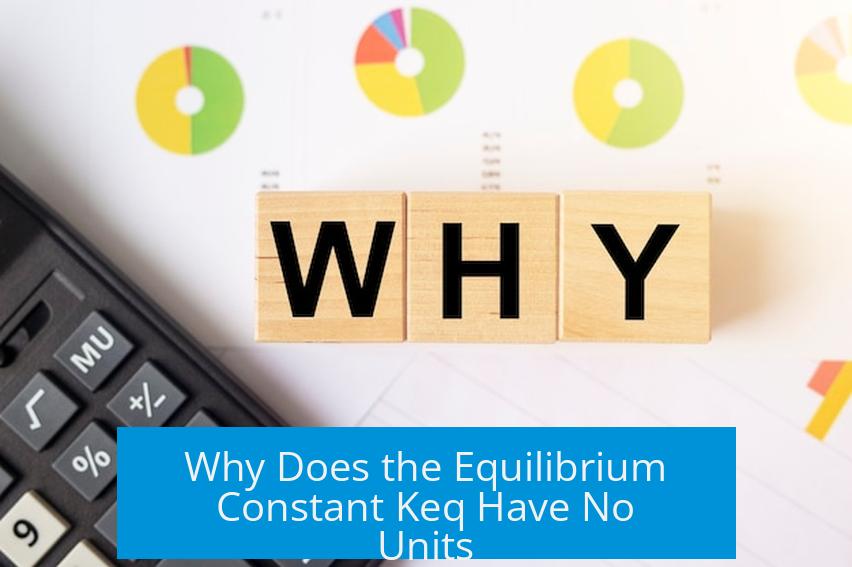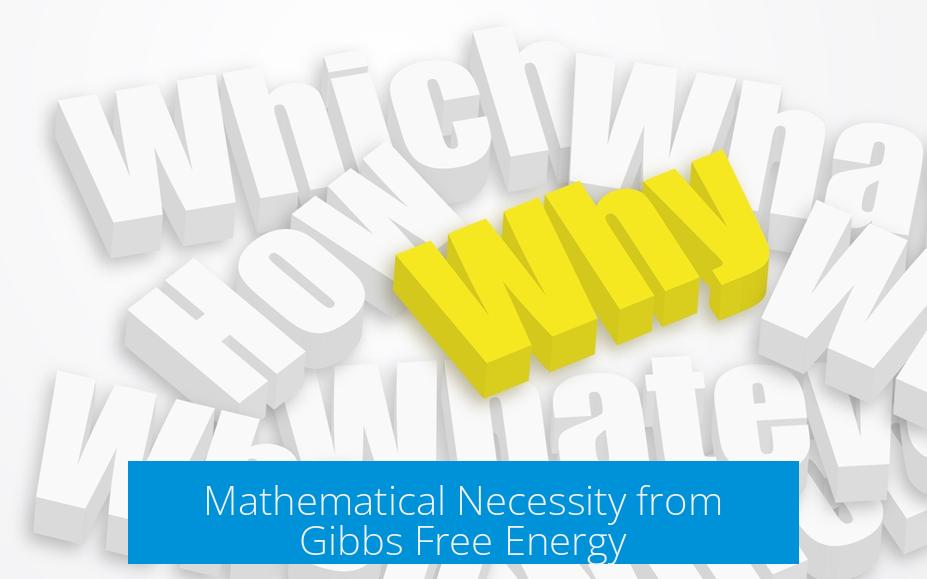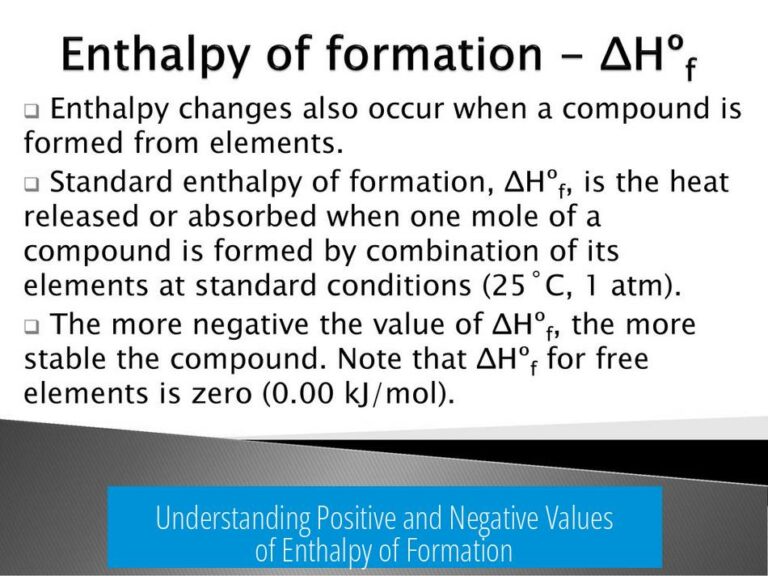Why Does the Equilibrium Constant Keq Have No Units?
 The equilibrium constant, Keq, has no units because it is fundamentally defined in terms of dimensionless quantities known as activities. Activities normalize concentrations or partial pressures against standard reference states, removing units and ensuring thermodynamic consistency. This dimensionless nature is essential for correctly relating Keq to thermodynamic functions such as Gibbs free energy. The following sections explain this concept in detail.
The equilibrium constant, Keq, has no units because it is fundamentally defined in terms of dimensionless quantities known as activities. Activities normalize concentrations or partial pressures against standard reference states, removing units and ensuring thermodynamic consistency. This dimensionless nature is essential for correctly relating Keq to thermodynamic functions such as Gibbs free energy. The following sections explain this concept in detail.
Role of Activity in Defining Keq
Keq is not based directly on concentrations or partial pressures. Instead, it uses activities of reactants and products, which reflect the effective “active” amount of each species in a reaction mixture. Activity is a quantity that accounts for real solution behavior and interactions between molecules.
Unlike concentrations, activity is unitless. It represents the ratio of the concentration of a species to a reference standard concentration, typically 1 mol/L for solutions. This ratio removes units, so when all activities are combined in the equilibrium expression, the result is unitless as well.
- Activities model deviations from ideality in concentrated solutions.
- They provide a corrected measure of species behavior relative to standard conditions.
- Keq expresses the balance of these corrected, unitless quantities.
From Concentration to Dimensionless Quantities
When writing an equilibrium expression, the concentration of each species is normalized by a standard state concentration, often denoted as a, which has the same units as concentration (mol/L). The expression for activity looks like this:
Activity of A = [A] / a
Here, [A] is the molar concentration of species A, and dividing by a cancels the units, rendering the activity dimensionless.
All concentrations in the equilibrium constant expression undergo this normalization. Consequently, the entire Keq becomes a ratio of dimensionless activities, resulting in a dimensionless number.
Mathematical Necessity from Gibbs Free Energy

Keq is linked with thermodynamics through the relation:
ΔG° = -RT ln Keq
In this formula:
- ΔG° has units of energy per mole (J/mol).
- R (gas constant) has units J/(mol·K).
- T (temperature) has units K.
This implies that the natural logarithm argument, Keq, must be dimensionless because logarithmic functions cannot take arguments with units. Mathematically, taking the logarithm of a quantity with units is undefined.
The only way to satisfy this is by defining Keq as a dimensionless quantity. It reinforces why activity, and by extension Keq, must be unitless for thermodynamic equations to hold.
Why Units Appear to Cancel Out
In simpler cases, one might analyze units of concentration terms in the equilibrium expression and see them canceling. For example, given the reaction:
aA + bB ⇌ cC + dD
The equilibrium constant is expressed as:
Keq = ([C]^c [D]^d) / ([A]^a [B]^b)
Each concentration has the unit of molarity (M), so algebraically, the units may seem to reduce to M(c+d)-(a+b). But due to normalization to standard states, these apparent units are not physically meaningful.
Conventionally, one treats these terms as normalized activity ratios, so any units cancel out by construction, and the final Keq is dimensionless.
Activity Corrects for Real Solution Behavior
Ideal solutions assume that species behave independently, but real solutions show deviations especially at higher concentrations. Activities introduce corrections to account for this:
- They typically adjust measured concentration values downward to reflect molecular interactions reducing effective concentration.
- For example, in solubility equilibria, activity coefficients modify ion concentrations to yield accurate solubility product constants.
- These corrections usually amount to small percentage changes rather than large shifts.
Because activity is tied to the thermodynamic properties of species in a mixture, it ensures that Keq reflects real conditions while remaining dimensionless and consistent with fundamental laws.
Summary of Key Points

- Keq is defined in terms of activities, which are unitless ratios of concentration to standard state.
- The dimensionless nature is necessary for taking the logarithm in the Gibbs free energy equation.
- Apparent units in concentration terms cancel out upon normalization; pure algebraic unit analysis is insufficient to explain dimensionless Keq.
- Activities incorporate corrections for non-ideal solution behavior, ensuring accuracy in equilibrium calculations.
- Thermodynamic consistency demands Keq be dimensionless for correct physical interpretation and calculation.
Why Does the Equilibrium Constant Keq Have No Units?
The equilibrium constant Keq has no units because it’s fundamentally derived from dimensionless quantities called activities, not raw concentrations or pressures. This dimensionless nature ensures that the logarithmic expressions in thermodynamics remain valid and physically meaningful.
Sounds like chemistry magic, right? Let’s unravel this mystery. Why does Keq, which you often see written with concentrations or partial pressures, end up being completely unitless? Spoiler alert: it’s all about how scientists measure things behind the scenes.
Activity vs. Concentration: Not Just Chemical Hair-Splitting
Most of us first learned that the equilibrium constant relates concentrations of reactants and products. So, it’s easy to imagine Keq has units like molarity raised to certain powers. But here’s the kicker: the truth is Keq is expressed in terms of “activity,” not concentration.
Activity may sound like chemistry jargon, but it’s actually a clever way to account for how species behave in real-world solutions — including the quirks and non-ideal behavior you won’t see in a classroom. Think of activity as the “effective concentration,” adjusted so we can fairly compare chemicals even when solutions are crowded.
- Activity behaves like concentration but has no units.
- It factors in interactions between molecules, especially at higher concentrations.
- By using activity, scientists align the reaction to thermodynamic principles.
So, when writing the equilibrium expression, what looks like a concentration is actually a ratio of concentration divided by a standard reference concentration — making it dimensionless!
How Do You Make Concentrations Dimensionless? Meet the “Fudge Factor”

You might wonder, “How can concentration, inherently measured in moles per liter, become unitless?” It’s done by dividing actual concentration [A] by a standard reference concentration a (often 1 M), which carries the unit mol/L but acts as a scale factor.
That’s right: [A]/a gives the ratio of the concentration to this reference value, effectively cancelling units. No more moles per liter baggage!
This small but critical step means each term in the equilibrium expression is now a pure number, which ensures the entire expression is dimensionless. Without this, we’d be stuck with an awkward mix of units that don’t unite well in thermodynamics or math.
The Mathematical Proof: Thermodynamics Doesn’t Lie
Thermodynamics demands Keq be unitless. Consider the fundamental equation linking Gibbs free energy change to equilibrium:
ΔG = -RT ln(K)
Here, R is the gas constant (J/mol·K), T is the temperature in Kelvin (K), and ΔG is energy per mole (J/mol). For the equation to make sense, the natural logarithm ln(K) must be dimensionless because logarithms simply don’t work with units. You can’t take the logarithm of “molarity” or “atm” any more than you can add apples and oranges!
The only way to keep ln(K) happy is if K itself is dimensionless. This realization explains the use of activities and the normalization of concentrations in equilibrium calculations.
A Quick Algebra Lesson: Units Cancel Out Like a Good Magic Trick
From a beginner’s perspective, Keq is given by the product of concentrations of products raised to their stoichiometric coefficients over those of reactants. Since all concentrations are measured in the same units, these units cancel out algebraically—or so you’d think.
Sometimes, depending on the stoichiometry, this leads to units raised to powers (like molarity-n). Strictly speaking, this makes Keq seem to have units! But chemists conventionally treat these as normalized or irrelevant because they don’t reflect true thermodynamic quantities.
In essence, the dimensionless nature of activity reigns supreme and overrides any naive unit analysis, ensuring consistency across the board.
Real-World Impact: Why All This Matters
You might think: “Okay, units or no units, what difference does this make to me?” Great question! The introduction of activities corrects the equilibrium constants for real solution behavior, especially in highly concentrated or complex systems.
Activities account for subtle (but crucial) deviations from ideality, like how ions in a salty solution “feel” the presence of neighbors differently. This leads to more accurate predictions of reaction outcomes, solubility, and rates.
- Non-ideal solutions behave as if their effective concentration is slightly lower than measured.
- This correction typically shifts equilibrium constants by a few percent to tens of percent, which matters in precision work.
- Ignoring activity can lead to poor predictions in fields like pharmaceuticals, environmental science, or materials chemistry.
Consider solubility products where adjusted activity provides a better picture of actual dissolved ions, improving everything from crystal growth to water treatment.
Wrapping It Up: The Beauty of a Unitless Keq
So, here’s the deal: the equilibrium constant Keq has no units because it’s based on dimensionless activities, normalized concentrations to a standard reference, and grounded in fundamental thermodynamic principles requiring logarithmic arguments to be unitless.
This may not be the flashiest chemistry fact, but it ensures that all our calculations stand on solid mathematical and physical footing. Next time you see Keq, you can impress your friends by telling them it’s a unitless number that packs serious scientific wisdom.
And remember: in chemistry, just like in life, sometimes the most important things come with no units at all!
Why is the equilibrium constant Keq expressed without units?
Keq is calculated using activities, which are dimensionless. Activities normalize concentrations by a standard reference, removing units. This makes Keq itself dimensionless.
How does the logarithm in the Gibbs free energy equation relate to Keq being unitless?
The equation ΔG = -RT ln(K) requires ln(K) to be dimensionless. For the logarithm to be mathematically valid, Keq must have no units.
What role does activity play in making Keq unitless?
Activity adjusts for real solution behavior and normalizes concentration. It removes units by dividing concentration by a standard value, ensuring Keq is dimensionless.
Can Keq ever have units if we use concentrations directly?
Concentration units may seem to remain, but they cancel out when forming the ratio. Conventionally, Keq is considered unitless for thermodynamic consistency.
Why can’t the argument of a logarithm in science have units?
Logarithms only accept dimensionless inputs. If Keq had units, ln(Keq) would be undefined, breaking the thermodynamic equations that involve free energy.





Leave a Comment